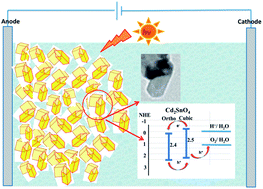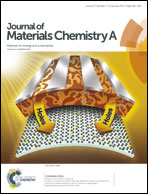Orthorhombic/cubic Cd2SnO4 nanojunctions: enhancing solar water splitting efficiency by the suppression of charge recombination†
Abstract
The low practical efficiency of binary metal oxide semiconductor-based photo-electrochemical (PEC) water splitting has prompted researchers to examine ternary and quaternary oxides, which provide more leverage for engineering the desired PEC properties via stoichiometry (valence) and phase control. One ternary system of interest in this context is cadmium tin oxide (Cd2SnO4), which supports the cubic and orthorhombic phases with optical, electronic and catalytic properties that are favourable for PEC water splitting. However, its practical PEC performance is limited by high surface recombination of the photogenerated charge carriers. In this work we circumvent this problem by engineering the constitution of Cd2SnO4 nanoparticles to a biphasic nanojunction form, comprising of a nanocomposite of cubic and orthorhombic phases. The favourable conduction band alignment between the cubic and orthorhombic phases leads to a dramatic reduction in the recombination of the photogenerated charges, leading to a 10-fold increase (from 250 μA cm2 to over 2 mA cm2) in the photocurrent vis-a-vis the single cubic or orthorhombic phase performance. We discuss the underlying mechanism for the observed dramatic enhancement in the water splitting efficiency.


 Please wait while we load your content...
Please wait while we load your content...